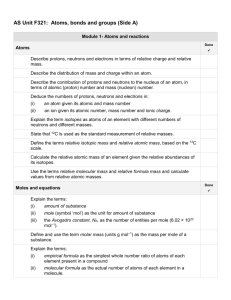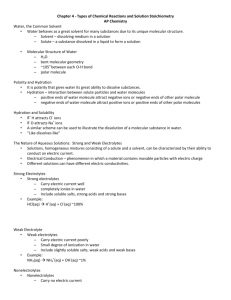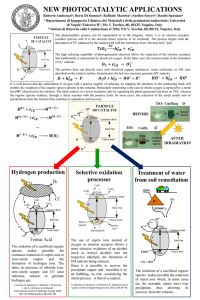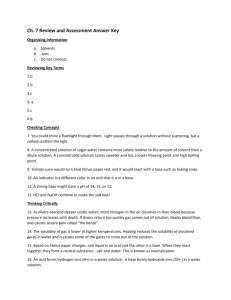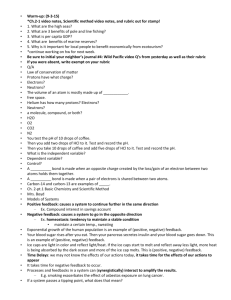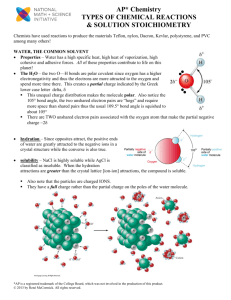AP Chemistry: Reactions & Solution Stoichiometry Notes
advertisement
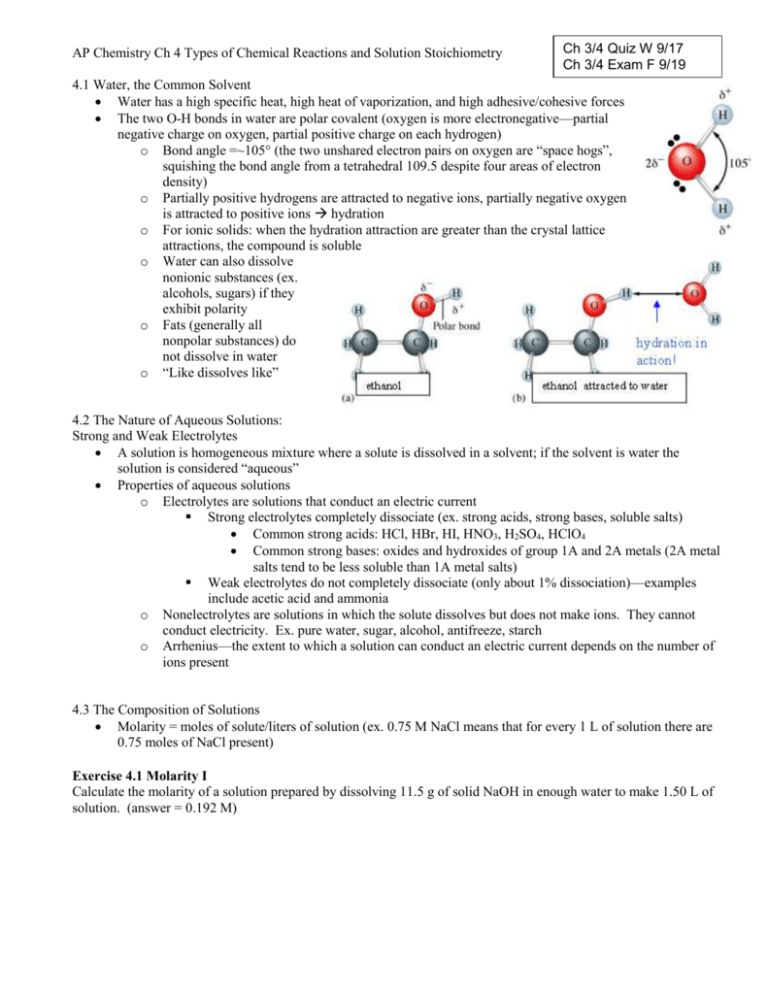
AP Chemistry Ch 4 Types of Chemical Reactions and Solution Stoichiometry Ch 3/4 Quiz W 9/17 Ch 3/4 Exam F 9/19 4.1 Water, the Common Solvent Water has a high specific heat, high heat of vaporization, and high adhesive/cohesive forces The two O-H bonds in water are polar covalent (oxygen is more electronegative—partial negative charge on oxygen, partial positive charge on each hydrogen) o Bond angle =~105° (the two unshared electron pairs on oxygen are “space hogs”, squishing the bond angle from a tetrahedral 109.5 despite four areas of electron density) o Partially positive hydrogens are attracted to negative ions, partially negative oxygen is attracted to positive ions hydration o For ionic solids: when the hydration attraction are greater than the crystal lattice attractions, the compound is soluble o Water can also dissolve nonionic substances (ex. alcohols, sugars) if they exhibit polarity o Fats (generally all nonpolar substances) do not dissolve in water o “Like dissolves like” 4.2 The Nature of Aqueous Solutions: Strong and Weak Electrolytes A solution is homogeneous mixture where a solute is dissolved in a solvent; if the solvent is water the solution is considered “aqueous” Properties of aqueous solutions o Electrolytes are solutions that conduct an electric current Strong electrolytes completely dissociate (ex. strong acids, strong bases, soluble salts) Common strong acids: HCl, HBr, HI, HNO3, H2SO4, HClO4 Common strong bases: oxides and hydroxides of group 1A and 2A metals (2A metal salts tend to be less soluble than 1A metal salts) Weak electrolytes do not completely dissociate (only about 1% dissociation)—examples include acetic acid and ammonia o Nonelectrolytes are solutions in which the solute dissolves but does not make ions. They cannot conduct electricity. Ex. pure water, sugar, alcohol, antifreeze, starch o Arrhenius—the extent to which a solution can conduct an electric current depends on the number of ions present 4.3 The Composition of Solutions Molarity = moles of solute/liters of solution (ex. 0.75 M NaCl means that for every 1 L of solution there are 0.75 moles of NaCl present) Exercise 4.1 Molarity I Calculate the molarity of a solution prepared by dissolving 11.5 g of solid NaOH in enough water to make 1.50 L of solution. (answer = 0.192 M) Exercise 4.2 Molarity II—ions Calculate the concentration of the cobalt (II) ions and the nitrate ions in a 0.50 M solution of cobalt (II) nitrate. (answer = 0.50 M Co2+ and 1.0 M NO3-) Exercise 4.3 Moles and Molarity Calculate the number of moles of Cl- ions in 1.75 L of 0.001 M ZnCl2. (answer = .0035 moles Cl-) Exercise 4.4 Volume and Molarity Typical blood serum is about 0.14 M NaCl. What volume of blood contains 1.0 mg NaCl? (answer = 0.12 mL) A standard solution is a solution whose concentration is accurately known. To prepare a solution of known concentration, weigh out the solid as accurately as possible and place it in a volumetric flask. Add enough just enough distilled water to dissolve the solid and then fill to the mark on the flask. Mix. Exercise 4.5 Standard Solutions To analyze the alcohol content of a certain wine, a chemist needs 1.00 L of an aqueous 0.200 M potassium dichromate solution. How many grams of solid K2Cr2O7 are needed to make this solution? Dilution o M1V1 = M2V2 o Generally, you measure out the quantity of stock (concentration) solution that you calculate from the formula above, and place it in a volumetric flask (of the correct volume for your dilution). Next you fill the volumetric flask to the mark on the neck with distilled water until the meniscus is reached. Mix. Exercise 4.6 Dilution What volume of 16 M sulfuric acid must be used to prepare 1.5 L of a 0.10 sulfuric acid solution? (answer = 9.4 mL) 4.4 Types of Chemical Reactions Review terms: chemical reaction, balanced chemical equation, (s), (l), (g), (aq) Not all reactions fall neatly into one category 4.5 Precipitation of Reactions The formation of a precipitate is the driving force for some chemical reactions. A precipitate is an insoluble solid that is formed when two aqueous solutions are mixed. We can separate the precipitate from solution by filtration in what is called gravimetric analysis. You have to know the solubility rules o o o o o Most alkali metal salts and ammonium salts are soluble Chloride, bromide, and iodide are soluble—except for Ag+, Hg22+, and Pb2+ Nitrates, chlorates, perchlorates, and acetates are soluble Sulfates are soluble—except for Ca2+, Sr2+, Ba2+, Ag+, Hg22+, and Pb2+ Carbonates, phosphates, chromates, dichromates, sulfides, hydroxides, and oxides are insoluble—but the first rule (most alkali metal salts and ammonium salts are soluble) takes priority o It can be assumed that ionic compounds that dissolve in water are strong electrolytes. Exercise 4.7 Solubility Rules Predict what will happen when the following pairs of solutions are mixed. Potassium nitrate and barium chloride Sodium sulfate and lead (II) nitrate Potassium hydroxide and iron (II) nitrate 4.6 Describing Reactions in Solution Complete balanced equation—gives the overall reaction stoichiometry but does not specify which reactants/products ionize Complete ionic equation—same as above but represents all strong electrolytes as ions Net ionic equation—includes only the solution components undergoing a change; spectator ions are not included o There is always a conservation of charge in net ionic equations Exercise 4.8 Three types of equations Aqueous potassium chloride is added to aqueous silver nitrate to form a silver chloride precipitate plus aqueous potassium nitrate. Write the complete balanced equation: Write the complete ionic equation: Write the net ionic equation: 4.7 Stoichiometry of Precipitation Reactions Precipitation reactions form an insoluble salt; this salt is dried and its mass is obtained We can use stoichiometry to determine the expected/needed quantities of each compound Exercise 4.9 Precipitation Reaction Stoichiometry I Calculate the mass of solid sodium chloride that must be added to 1.50 L of a 0.100 M silver nitrate solution to precipitate all of the silver ions in the form of AgCl. (answer = 8.77 g NaCl) Exercise 4.10 Precipitation Reaction Stoichiometry II When aqueous solutions of sodium sulfate and lead (II) nitrate are mixed, lead (II) sulfate precipitates. Calculate the mass of lead (II) sulfate formed when 1.25 L of 0.0500 M lead (II) nitrate and 2.00 L of 0.0250 M sodium sulfate are mixed. (answer = 15.2 g lead (II) sulfate) 4.8 Acid-Base Reactions Acids are compounds that produce anions and hydronium ions (H3O+) when they react with water (you can also just say hydrogen ions, H+, though hydronium is technically more correct)—Arrhenius definition Bases are compounds that produce cations and hydroxide ions when they react with water—Arrhenius definition o NH3 is therefore not an Arrhenius acid, but it IS a Bronsted-Lowry acid because it is a proton acceptor In a neutralization reaction, an acid and a base in equimolar (really equinormal) quantities react to produce water and a salt. The salt may or may not be soluble. Exercise 4.11 Neutralization What volume of a 0.100 M HCl solution is needed to neutralize 25.0 mL of 0.350 M NaOH? (answer = 0.0875 L = 87.5 mL HCl) Acid-Base Titrations o Volumetric analysis is a technique for determining the amount of a certain substance by doing a titration o Review term: titrant, analyte, burette, indicator o The equivalence points occurs when the number of moles of hydroxide ions is equal to the number of moles of hydrogen (hydronium) ions—this term is also used in redox titrations o Standardization is a procedure for establishing the exact concentration of a reagent—ex. you may prepare a solution to be 0.50 M but it might be “off”; standardization helps you to determine the true concentration Exercise 4.12 Standardization A student carries out an experiment to standardize a sodium hydroxide solution. To do this the student weighs out a 1.3009 g sample of potassium hydrogen phthalate (KHC8H4O4 abbreviated KHP, molar mass 204.22 g/mol, has one acidic hydrogen). The student dissolves the KHP in distilled water, adds phenolphthalein as an indicator, and titrates the resulting solution with the sodium hydroxide solution to the phenolphthalein endpoint. The difference between the final and initial burette readings is 41.20 mL. Calculate the concentration of the sodium hydroxide solution. (answer = 0.1546 M NaOH) 4.9 Oxidation-Reduction Reactions Terms to know o OIL RIG (oxidation is loss, reduction is gain, of electrons) o Oxidation is the loss of electrons, which increases charge (more positive) o Reduction is the gain of electrons, which decreases charge (more negative) o Oxidation number is the assigned charge on an atom o Oxidizing agents get reduced, reducing agents get oxidized—reduction and oxidation must be coupled Rules for assigning oxidation states o Always zero for elements o The oxidation state of a monatomic ions is the same as its charge o Fluorine is always -1, oxygen is almost always -2 (exceptions—peroxides where it is -1, or OF2 where it is +2) o Hydrogen is almost always +1; metal hydrides are an exception, where it is -1 (in these situations, hydrogen is placed at the end of a chemical formula like LiH) o The sum of the oxidation states must be zero for a neutral compound; for polyatomic ions, the sum of the oxidation states must equal the charge on the polyatomic ion o It’s odd, but there can be non-integer oxidation states. Ex. Fe3O4 where the oxygens total -8, so iron’s charge must be +8/3 Fe+8/3 Exercise 4.13 Oxidation States Assign oxidation states to each atom in the following compounds/ions. CO2 SF6 NO3- C= S= N= O= F= O= Exercise 4.14 Oxidation and Reduction I For the following reaction, identify the atoms that are oxidized and reduced. 2 Al(s) + 3 I2(s) 2 AlI3(s) Now go back and identify the oxidizing and reducing agents. Exercise 4.15 Oxidation and Reduction II The following reactions are associated with metallurgy. 2 PbS(s) +3 O2(g) 2 PbO(s) + 2 SO2(g) PbO(s) + CO(g) Pb(s) + CO2(g) For each reaction, identify the atoms that are oxidized and reduced Then identify the oxidizing and reducing agents. 4.10 Balancing Oxidation-Reduction Equations Divide the equation into oxidation and reduction half reactions (OIL RIG) Balance all elements besides hydrogen and oxygen Balance oxygen by adding water to the appropriate side of the equation Balance hydrogen by adding hydrogen ions to the appropriate side of the equation Balance the charge by adding electrons Multiply the half reactions to make the electrons equal for oxidation/reduction reactions Cancel terms when you recombine the two half reactions These rules are for acidic solutions; if this takes place in a basic solution, you have one more step. Neutralize any hydrogen ions by adding the same number of hydroxide ions to each side; check your water and cancel terms as necessary Check Sample problem 1 o Balance the following equation using the half-reaction method (acidic): MnO4-(aq) + I-(aq) Mn2+(aq) + I2 (aq) Reduction: Oxidation: Combined: Sample problem 2 o Balance the following equation using the half-reaction method (basic): Ag(s) + CN-(aq) + O2(g) Ag(CN)2-(aq) Reduction: Oxidation: Combined: Exercise 4.15 Balancing Half Reactions Potassium dichromate reacts with ethanol (C2H5OH) as follows: H+(aq) + Cr2O72-(aq) + C2H5OH(l) Cr3+(aq) + CO2(g) + H2O(l) Balance this equation using the half-reaction method.



